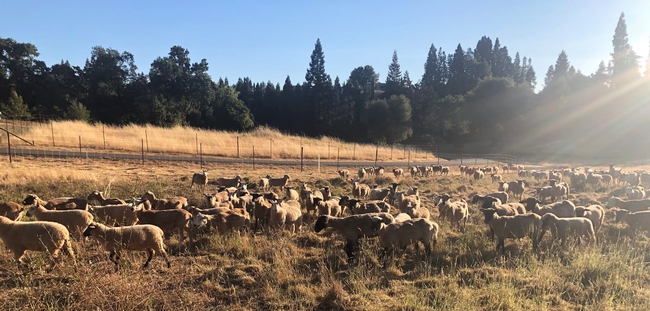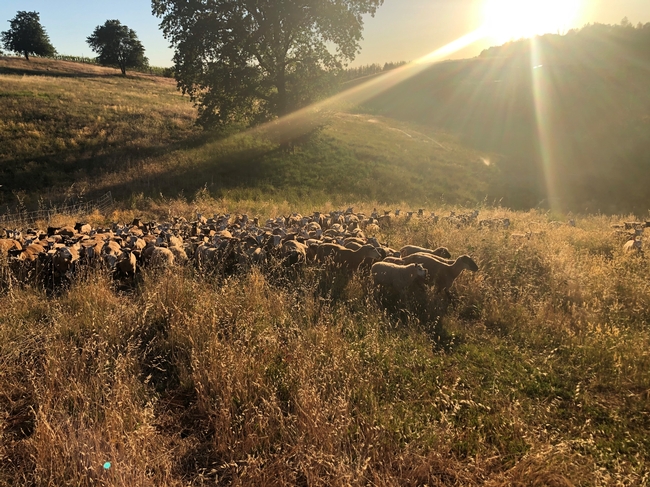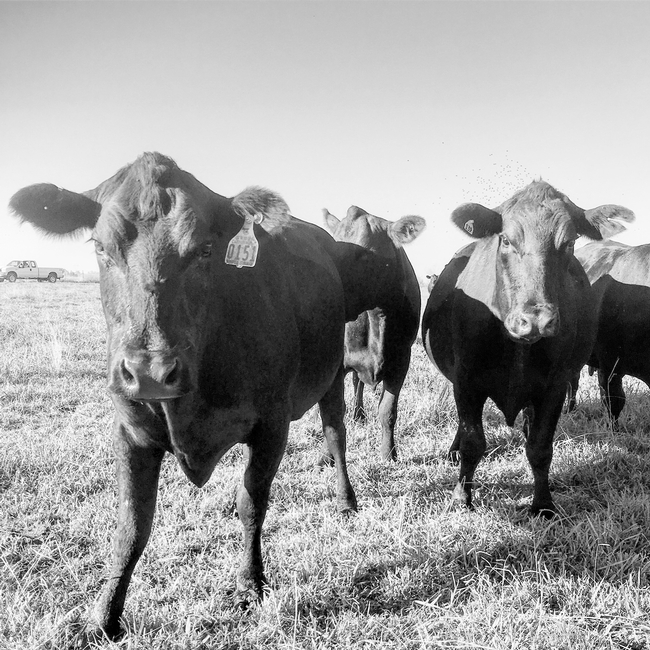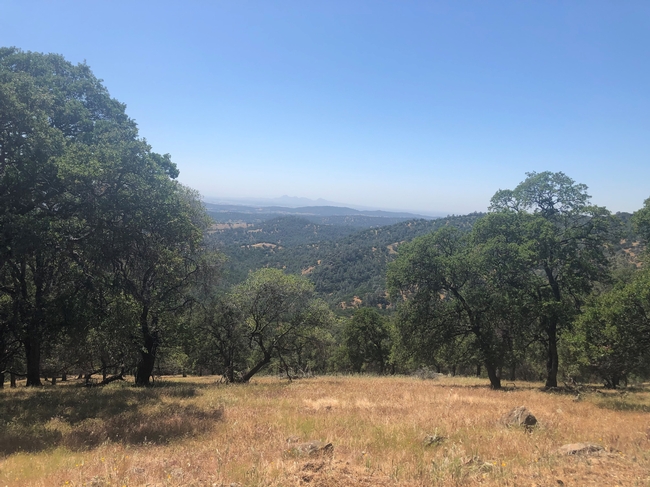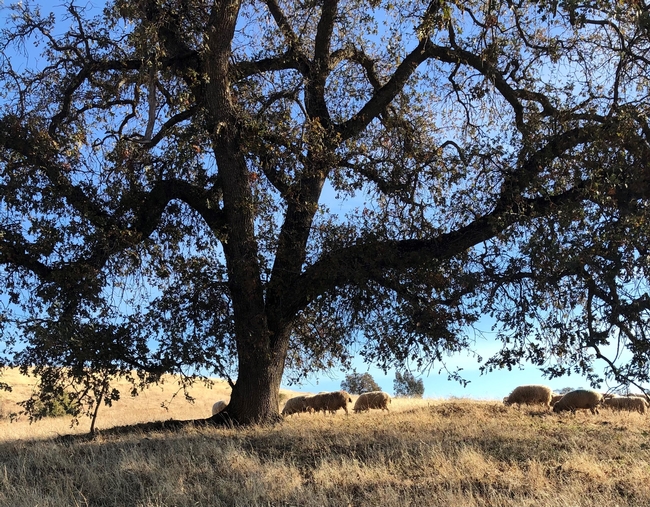- Author: Dan Macon
Ranching, like any other agricultural business, requires a considerable amount of planning. Unlike some farming businesses, however, ranching also requires a certain level of comfort with conditions that are beyond our control. Unexpected problems can certainly "crop" up for irrigated crop production, but we generally have some lead time to make decisions about planting or finding alternative sources of irrigation water. While I don't mean to diminish the challenges that all of us in California agriculture are facing in this incredibly dry year, I think looking down the road is different for rangeland livestock producers than for anyone else.
As I wrote last month (Yup - this is a Drought!), drought can seem like a slow-moving emergency. After a late start to our grass year in November 2020, I held out hope that we'd get something like normal precipitation in early 2021. We did not; our dry spring locked in certain parts of our forage planning process. For example, the feed that had grown by the time we shipped ewes and lambs off of our winter rangeland and back to irrigated pasture in early April was all that we'd have to work with for the rest of the year. No more rain meant no more growth.
Other parts of our annual forage calendar are less certain this year. For the first time in the 16 years I've irrigated pasture for our sheep, we're facing the potential of a mandatory reduction in our irrigation water deliveries this year. The Nevada Irrigation District, who delivers our water from the high country, is looking at the lowest carryover potential in its reservoirs in its 100 year history. Consequently, the district may end our irrigation season early, or give us less water for the full season (which typically ends on October 15). This uncertainty about our irrigated pasture compounds the ambiguity about our fall forage supply - we never know when the first germinating rain will arrive, which makes planning difficult.
For many of us who rely on annual rangeland, then, autumn is perhaps our most precarious season. Many of us try to stretch our irrigated pasture as long as we can - hoping it will last until the fall rains green-up our rangeland forages. Most of us try to manage our spring grazing to conserve dry forage for the fall - just in case the rains come late.
In our small operation, we've found that a 12-month forage calendar helps us identify future problems before they require drastic (e.g., expensive) decisions. For each of the next 12 months, we try to estimate whether we'll have adequate forage. If we think the forage will be inadequate, we try to determine why. Is it a lack of quantity (are we going to be out of feed)? Is it insufficient quality (is our forage too low in protein or energy for the stage of production we're in)? Or is it a lack of stock water? By thinking through our forage projections, we're able to think about strategies for addressing them:
- If we're going to be out of feed, do we need to think about selling some animals?
- If we have dry feed that we're trying to graze with pregnant ewes, we can supplement their protein. We start thinking about buying protein now before everyone's looking for it (and driving up the price).
- If we're worried about a lack of stock water, we start thinking about how we can get water to our sheep (so they can graze the forage we've conserved).
I wish I had a crystal ball that would tell me the exact date we'd get a germinating rain - it would make planning so much easier. Without a crystal ball, however, we can start looking down the road. We can - and should - start planning now for how we're going to get through next fall and winter. Our new Drought Decision Support Tool for Ranchers provides a framework for thinking about your forage future - check it out and please provide feedback!
- Author: Dan Macon
I sat (virtually) through a local irrigation district board meeting this morning. As you might imagine in a year like this, drought was on everybody's mind, from elected board members to staff to customers. The district has already asked for voluntary water conservation; next month, their board will likely consider mandatory cutbacks. And this district isn't alone - the Browns Valley Irrigation District, for example, has announced that it will end irrigation water deliveries in late August or early September (roughly 45 days earlier than normal). 2021 is shaping up to be an incredibly difficult year.
Given the likelihood that we'll be facing irrigation water reductions at some point this season, we're starting to think about our management options now. What is the best approach for keeping pastures going this year? Are there some things we can do this season to improve pasture survival for next year? Thankfully, some of my UCCE colleagues dove into this topic during the last drought. This publication is especially helpful!
First, we've noticed that the soil profile was very dry by the time we got irrigation water in mid April - and other ranchers have reported similar observations. Ranchers with flood irrigation systems were finding that it took much longer to get water to the end of the field because of these dry conditions. With our pod sprinkler system, it took us two full rotations to get the soil profile full and begin meeting plant demand. Our local irrigation district reported that these dry conditions have resulted in mid-summer irrigation demand - in early May!
With the prospect of water reductions, we need to evaluate the resiliency of the forage species and varieties in our pastures. Some grasses are more drought tolerant than others. At this stage, we can't really do much to shift to a more drought tolerant forage in the midst of the grazing season, but we can adjust our irrigation, fertilization, and grazing strategies to address the needs of the specific species and varieties.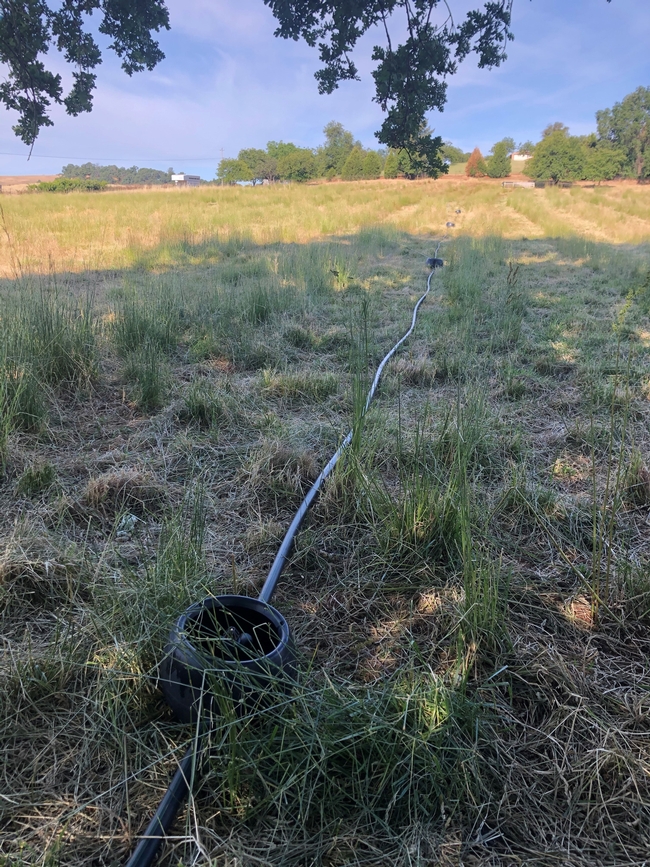
Many foothill and Sacramento Valley pastures go through an annual succession of forages, with cool-season grasses and legumes like tall fescue, orchard grass, and white clover dominating early in the growing season. As temperatures warm, we tend to see more warm-season grasses like dallisgrass and bermuda. With the return of cooler temperatures and longer nights in late summer and early fall, the cool-season often rebound. The warm-season grasses are typically more drought tolerant, as you might imagine. Of the cool-season grasses, species and variety matter. In general, tall fescue seems to be more drought tolerant than orchardgrass, although there are some drought tolerant orchardgrass varieties. Most of our clover varieties, unfortunately, don't have much drought tolerance.
So how should we manage this year? And what can we expect next year? These recommendations are largely adapted from an excellent video produced by my late UCCE colleague, Steve Orloff (click here to view the video):
- Protect plant crowns: avoid grazing below 3" stubble height (and more residual may be better). The plant crown and stubble store sugars and carbohydrates essential for subsequent regrowth. Protecting these plants this fall increases the likelihood that they'll survive into next year.
- Know your pasture plants and pasture soils: prioritize irrigating those fields or portions of fields that can withstand drought. Focus on keeping drought-tolerant forage plants going - the less drought-tolerant plants may need to be replanted regardless of your management. Know where your deeper soils are - in our foothill pastures, these are typically at the foot of slopes. Generally, these deeper soils can hold onto water longer.
- Collect soil samples and target your fertilizer applications: Fall applications of potassium and phosphorous can help stimulate root growth, but it's always helpful to know your baseline fertility. Nitrogen application during drought, however, can concentrate nitrates (and be harmful to grazing livestock).
- Focus on recovery periods: While I think it's ALWAYS critical to vary grazing rotations based on the recovery period of the pasture, drought makes this even MORE important. In short feed years, it's always tempting to come back to a field before it's fully recovered from the last graze. DON'T DO IT! Allowing plants to recover fully will enhance root growth and pasture resiliency.
- Think about next year: If our water shuts off early, we may lose some of our clover - consider over-seeding clover just before the first fall rain. One of the more interesting ideas in the video referenced above was the possibility of planting an annual cereal crop (like triticale) before the water shuts off - and grazing in the fall and again in the spring (assuming something like "normal" winter precipitation). This is something I'll need to think through, but I'm intrigued by the idea.
As always, I'm available to come to your pasture to talk about these options and your specific situation. And we're hoping to do an on-ranch, in-person workshop later this summer to discuss these strategies in more detail. Feel free to contact me at dmacon@ucanr.edu or (530) 889-7385!
- Author: Dan Macon
If you've read my blog posts or newsletters over the last four years, you'll probably recognize that drought is a recurring theme - in my writing, in my extension programming, and in my research. Having ranched through the 2012-2015 drought, I tend to get a little nervous whenever we go through an unusual dry and/or warm stretch during our "normal" rainy season. And over the last six months, I've written about drought planning, feeding supplemental protein to utilize dry forage, and options for hauling drinking water to livestock. But all of these blog posts were written with the hope that we still had time for the rains to come - that we still had time to avoid a second consecutive dry year. Now that we're in the first week of May, I can say with more confidence (not to mention, disappointment) - we're in a drought here in the Sierra foothills.
I suppose most of us think about lack of rain or snow when we think of drought - and that's been a feature of this year's drought, to be sure. Through April 30, we've measured 18.7 inches of rainfall for the water year (since October 1, 2020). In the 20 years I've kept records here in Auburn, this is the lowest amount of precipitation I've recorded - lower, even, than the 2013-14 drought. As of May 1, we're sitting at 62 percent of average, based on my records.
But rainfall doesn't tell the whole story of this year's drought. January 2021 was the only month if this water year with above average rainfall. April, on the other hand, saw us measure just 6 percent of our average monthly precipitation. In fact, I've come to think of drought as a "climatic water deficit" - an event that combines low precipitation with higher environmental water demand, which we've also seen in the foothills this year.
The factors that drive this higher demand are numerous. Since last year was drier and warmer than normal, I suspect that we entered the current water year with very dry soils. This year's rainfall never truly re-saturated these soils, as evidenced by the lack of flow in our seasonal creeks - this is the first spring since I've lived in Auburn that I didn't see water in the ephemeral creeks where we graze our sheep. Secondly, many of the blue oaks in the lower foothills began to leaf out in late February, which increased evapotranspiration demand significantly (and earlier than normal). Finally, we've had a number of north wind events (the most recent of which created red flag fire conditions in early May) - these dry winds, and the associated low relative humidity levels, pull moisture out of vegetation and soil alike.
Local evapotranspiration data bears this out! The Auburn CIMIS (California Irrigation Management Information System) station recorded 6.0 inches of precipitation between February 1, 2021, and April 30, 2021 (similar to my data). Total evapotranspiration (water lost to evaporation or taken up by plants) during the same period was just over 12 inches. No wonder soil moisture in our rangelands was virtually nonexistent on May 1!
So what does this drought mean for us as rangeland livestock producers? In our operation, we feel reasonably confident that we'll have enough summer irrigation water to grow our typical summer forage, but I know other regions where summer water will be short. On our annual rangelands, which are critical to our fall and winter forage needs, we're seeing the feed mature at least a month earlier than normal. I suspect our peak standing crop (that is, the total amount of forage produced) will be lower than the long term average. Our fall grazing plans assume that we'll need to ration out this standing dry forage until we get a germinating rain. We'll be taking inventory of our fall forage resources in the next couple of weeks - if we look to be short of forage, we'll either look for more ground to graze or consider reducing our sheep numbers.
We'll also keep an eye on invasive weeds. The lack of late rain (so far) means less advantageous growing conditions for yellow starthistle. On the other hand, a quick visit to the UC Sierra Foothill Research and Extension Center today revealed that barbed goat grass is headed out a month earlier than usual!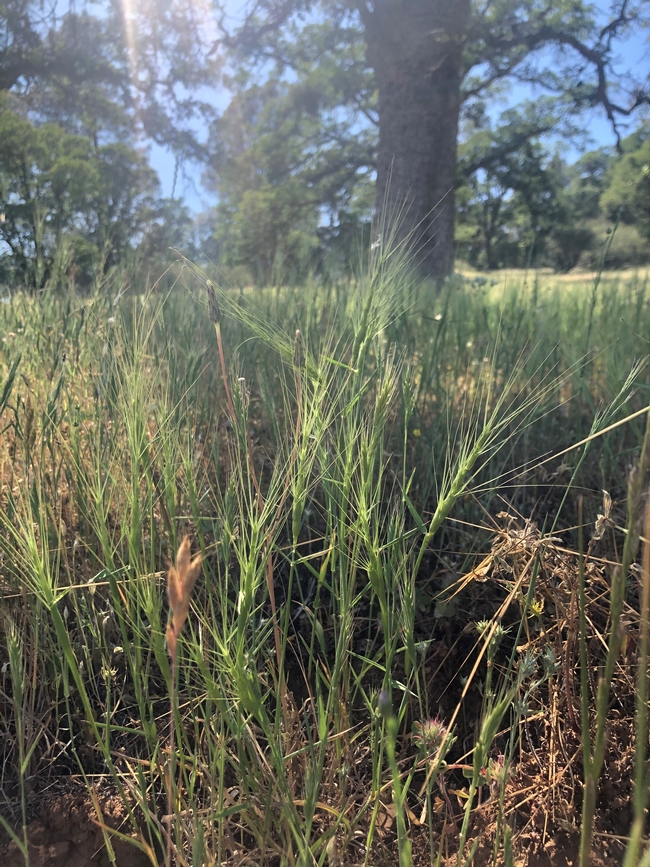
We won't, however, try to feed our way out of this drought. I've run the numbers on putting the ewes on full feed if we run out of standing forage (either on our irrigated pasture or our annual rangeland). The numbers simply don't pencil, and while I hate to sell sheep, I'd hate to go broke buying hay even more. If you haven't run your own numbers, I'd be happy to sit down with you and look at options. Obviously, there are also financial and tax implications of selling livestock - these are complicated and difficult decisions.
All of this brings me to what I consider to be the key lesson I learned from the last drought. The difficult decisions we face as livestock producers can be stressful and isolating. I found it helpful in 2014 - and I find it helpful now - to talk to other producers. Partly, I think, just knowing that our friends and neighbors are dealing with similar challenges can be reassuring. More importantly, sharing ideas and approaches to coping with this drought can help us expand our own toolboxes and to see alternatives we might be missing. Next week, we'll be hosting a webinar on drought planning and federal drought programs (click here to register). I would also encourage you to join the Farmer-Rancher Drought Forum on Facebook - this closed group is open only to farmers, ranchers, and agricultural professionals - and it can be great way to share ideas, learn from others, and simply to commiserate.
Many of us are facing some difficult decisions in the months to come - and some of us have already implemented some of these difficult choices. If you have questions - or simply want to talk through some of the drought-related issues you're grappling with, feel free to contact me at dmacon@ucanr.edu or (530) 889-7385.
- Author: Dan Macon
When we finally received a more than two inches of rain in mid-November, I was relieved that we would finally have germination on our foothill rangelands - better late than never! Today, after two weeks of sunshine, I am indeed seeing a little green coming up through last year's dry forage. But the forecast isn't promising - as of this morning (November 30), we have no rain in our forecast here in Auburn for the next two weeks. The combination of dry weather, short days, and colder (for here, at least) temperatures indicates that we won't likely grow much grass during the month of December.
Drought planning begins with proactive strategies - a conservative stocking rate, for example, or a production calendar designed to match periods of high forage demand with rapid forage growth. One of the most important proactive strategies in our small-scale sheep operation is grazing planning. Over the years, we've trained our eyes to estimate the amount of forage we have available - measured in sheep days per acre. While our estimates are not 100 percent accurate all of the time, the simple act of looking ahead and estimating the quantity and quality of standing forage gives us a better idea of when we might need to adjust our plans.
The second element of our planning process is the idea of key dates. For me, establishing a date by which we need to make a decision forces us to actually make the decision. During the 2013-2014 drought, Glenn Nader (who preceded me as UCCE livestock and natural resources advisor in Sutter and Yuba Counties) said, "The only way you're gonna survive a drought is to make decisions." This advice, obviously, has stayed with me - indecision prolongs the pain (economic and otherwise) of drought. In our operation, we look at forage conditions, weather forecasts, and our production calendar when establishing a key date. For example, our ewes will enter the last trimester of gestation in early January. At this point, their nutritional demand will begin ramping up significantly as they approach their lambing dates. While we've saved enough dry forage to get by for the next 5-6 weeks (which we can utilize by supplementing the ewes' protein intake), late gestation will require a different strategy. A key date also requires us to think about a condition that must be met for a decision to be triggered. This December, that condition is rainfall. If we haven't received an inch of rain by December 31, and if there is no rain in the 2-week forecast on that date, we'll need to make a decision.
This brings us to the last element of our drought plan - what are our options if we're still dry on New Year's Eve? For me, these reactive strategies are far less palatable - they cost us money (as in more expenses, less revenue, or both). Here are the options that are currently on the table:
- Purchase enough hay to get the ewes through late gestation and into the beginning of lambing season.
- Look for byproduct or other alternative protein and energy sources to feed the ewes.
- Sell older ewes to reduce forage demand.
- Sell replacement ewe lambs to reduce forage demand.
- Allow body condition to decline until the forage begins to grow (which may reduce lamb survival and future reproductive success).
- Find additional rangeland pasture to graze (this would still require some supplemental nutrition).
Over the next several weeks, we'll brainstorm additional options. We'll work through the economic ramifications of each of these options. We may choose a combination - perhaps we'd sell a few sheep and purchase hay to sustain the rest of the flock. The point here is that we've given ourselves a deadline for taking action, and we'll work through the numbers associated with each decision.
In the meantime, we'll keeping hoping for rain....
- Author: Dan Macon
October 2020 Beef Production and Targeted Grazing Webinars Now Available on YouTube!
Thank you to everyone who was able to join in one or more of our Beef Cattle and Targeted Grazing webinars during the month of October! We had great discussions on everything from managing parasites in cattle to bidding a targeted grazing job to managing pastures! I especially want to thank the Tahoe Cattlemen's Association for co-sponsoring the four cattle production sessions!
If you missed any of these webinars, or if you'd simply like to go back and review what you learned, I've loaded the videos of each session onto my YouTube channel! You can simply click the links below to watch the webinars!
An Introduction to Targeted Grazing (October 6) – learn the basics about managing targeted grazing for fuel load reduction and weed management.
Cattle Health with Dr. Gaby Maier and Dr. Becky Childers (October 15) – this webinar covers managing internal and external parasites, developing a vet-client-patient relationship, and how NOT to get fired by your veterinarian!
Beef Business Basics with Judd Tripp and JC Baser (October 20) – learn the basics of how to analyze your livestock business, and learn from the experiences of veteran Placer County ranchers.
Grazing Management Basics with Greg Lawley and Joe Fischer (October 22) – foothill ranchers discuss the art and science of managed grazing on rangeland and irrigated pasture.
The Business of Targeted Grazing with Bianca Soares (October 27) – learn about the business of targeted grazing, complete with tools for analyzing your own economic viability. The second half of this webinar features a question-and-answer session with an established targeted grazing contractor.
Beef Cattle Nutrition with Dr. Pedro Carvalho (October 29) – UC Davis/UCCE Feedlot Management Specialist Dr. Pedro Carvalho provides a basic overview of beef cattle nutrition in this final webinar.
And be sure to check out my Sheep Stuff Ewe Should Knowpodcast with fellow shepherd Ryan Mahoney – available on Spotify and Apple Podcasts! While our focus is on sheep, we cover topics of interest to most livestock producers!
If you have any questions, or ideas about future webinar or workshop topics, you can always contact me at dmacon@ucanr.edu or at (530) 889-7385.


